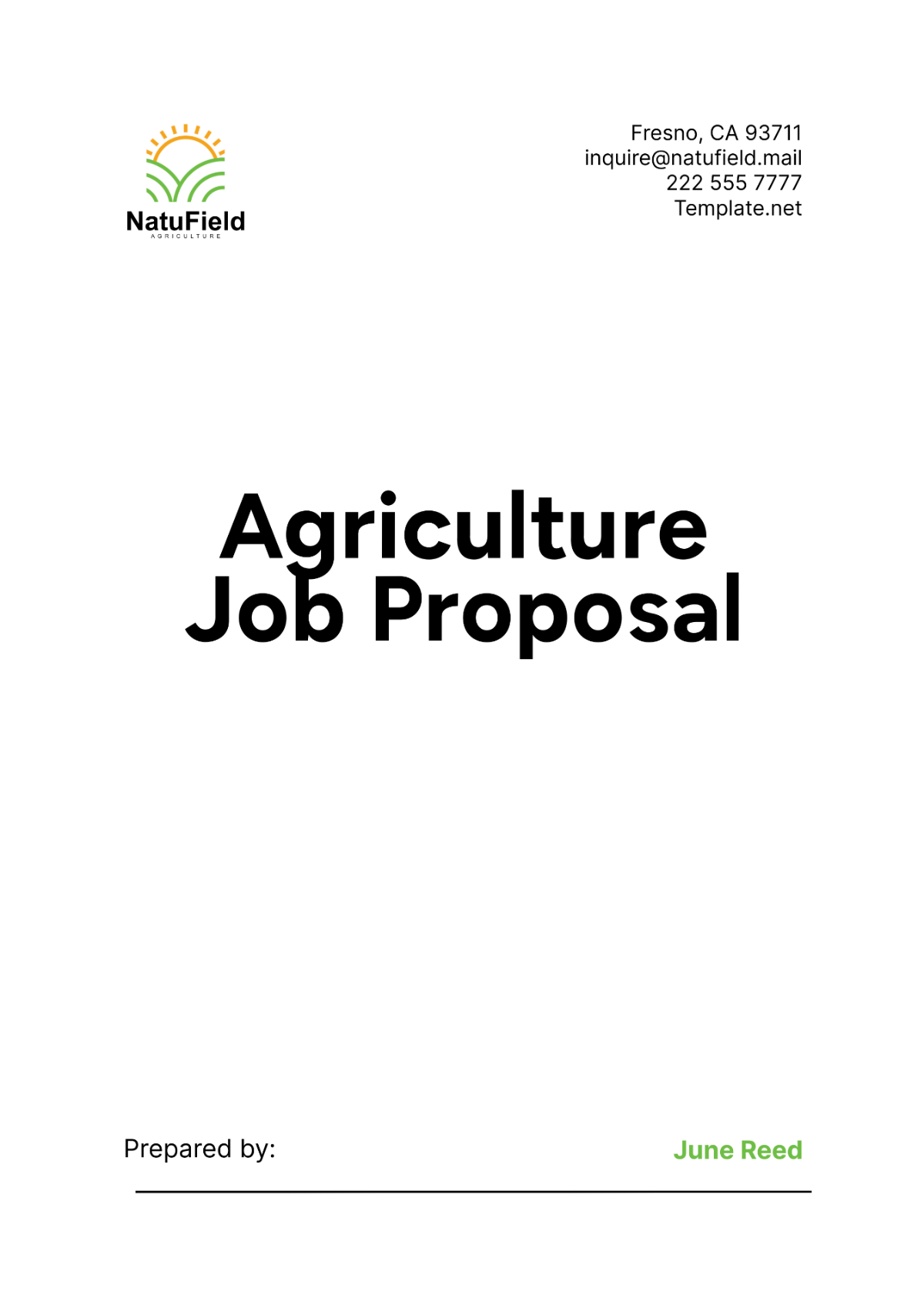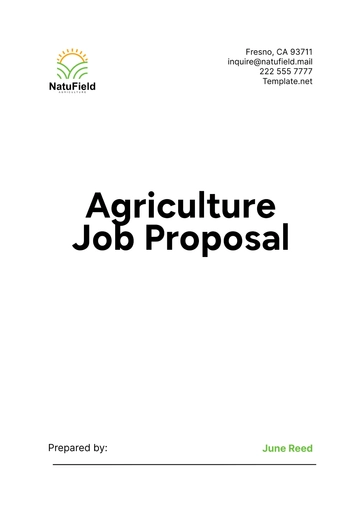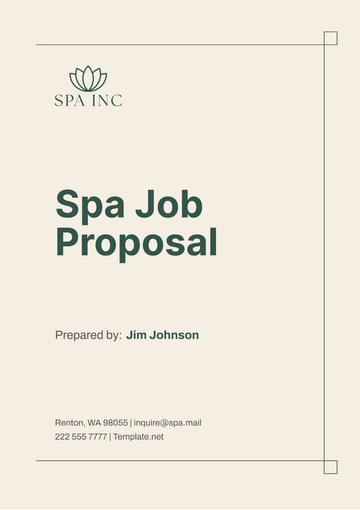Free Agriculture Job Proposal

I. Executive Summary
This Agriculture Job Proposal of [Your Company Name] outlines a strategic plan to create and fill key positions that will enhance our operational efficiency, foster innovation, and support sustainable agricultural practices. This proposal details the job roles, responsibilities, required qualifications, and projected budget necessary to achieve our organizational goals. This proposal is designed to address critical gaps in our workforce and ensure that we have the right talent to drive our agricultural initiatives forward.
The total budget for the proposed positions is $750,000, which covers salaries, benefits, training, and recruitment costs. We aim to fill these positions within the next six months, ensuring that the new hires are integrated smoothly into our operations. The timeline includes a detailed recruitment process, onboarding, and initial training phases.
By investing in skilled professionals, [Your Company Name] will be better positioned to implement advanced agricultural techniques, improve crop yields, and maintain our commitment to sustainability. This proposal underscores our dedication to building a robust and capable team that can navigate the challenges of modern agriculture and contribute to the long-term success of our company.
II. Job Roles and Responsibilities
A. Agronomist
Research and Development: Conduct research on crop production, soil management, and pest control. Develop new techniques to improve crop yield and quality.
Field Trials: Design and implement field trials to test new agricultural products and practices. Analyze data and report findings to improve farm practices.
Advisory Role: Provide expert advice to farmers on crop management, soil health, and pest control. Ensure best practices are followed for optimal results.
Sustainability Initiatives: Promote sustainable farming practices. Work on projects that reduce environmental impact and improve resource efficiency.
Collaboration: Work closely with other departments to integrate agronomic knowledge into broader company strategies. Foster cross-functional teamwork.
B. Farm Manager
Daily Operations: Oversee daily farm operations including planting, harvesting, and maintenance. Ensure all activities are performed efficiently.
Resource Management: Manage resources such as labor, equipment, and supplies. Optimize the use of resources to achieve productivity goals.
Budgeting: Develop and manage farm budgets. Monitor expenses and ensure financial sustainability.
Compliance: Ensure compliance with agricultural regulations and standards. Maintain high levels of safety and quality.
Training and Supervision: Train and supervise farm staff. Promote a culture of continuous improvement and professional development.
C. Agricultural Engineer
Equipment Design: Design and develop agricultural equipment and machinery. Innovate to improve efficiency and reduce costs.
System Integration: Integrate new technologies into existing farm systems. Ensure seamless operation and compatibility.
Maintenance: Oversee the maintenance and repair of agricultural machinery. Implement preventive maintenance schedules to avoid downtime.
Sustainability Projects: Lead projects focused on sustainable engineering solutions. Develop systems that reduce environmental impact.
Technical Support: Provide technical support and training to farm staff. Ensure they are proficient in using new equipment and technologies.
D. Quality Control Specialist
Standards Development: Develop and implement quality standards for agricultural products. Ensure all products meet regulatory and customer requirements.
Inspections: Conduct regular inspections of crops and products. Identify and address quality issues promptly.
Process Improvement: Analyze production processes and recommend improvements. Enhance product quality and consistency.
Training: Train staff on quality control procedures. Promote a culture of quality and continuous improvement.
Documentation: Maintain detailed records of quality control activities. Ensure transparency and accountability in quality management.
Customer Feedback: Collect and analyze customer feedback. Use insights to drive quality improvements.
III. Required Qualifications
A. Agronomist
Education: Bachelor's degree in Agronomy, Agriculture, or a related field. Advanced degrees preferred for higher expertise.
Experience: Minimum of five years of experience in agronomy or a related field. Proven track record of successful research and field trials.
Skills: Strong analytical, problem-solving, and communication skills. Proficiency in data analysis and research methodologies.
Certifications: Relevant certifications in agronomy or sustainable agriculture practices. Continuous professional development.
Attributes: Passion for sustainable farming and innovation. Ability to work independently and as part of a team.
B. Farm Manager
Education: Bachelor's degree in Agriculture, Farm Management, or a related field. Practical experience highly valued.
Experience: At least seven years of experience managing a large-scale farm. Demonstrated leadership and management skills.
Skills: Excellent organizational, budgeting, and resource management skills. Strong leadership and team-building abilities.
Certifications: Certifications in farm management or related fields. Ongoing professional development and training.
Attributes: Strong work ethic, reliability, and attention to detail. Ability to handle the physical demands of farm management.
C. Agricultural Engineer
Education: Bachelor's degree in Agricultural Engineering or a related field. Advanced degrees or specialized training preferred.
Experience: Minimum of five years of experience in agricultural engineering. Proven expertise in equipment design and maintenance.
Skills: Strong technical, analytical, and problem-solving skills. Proficiency in CAD software and engineering tools.
Certifications: Relevant engineering certifications. Commitment to continuous learning and professional growth.
Attributes: Innovative mindset and a passion for sustainability. Ability to work collaboratively and communicate effectively.
D. Quality Control Specialist
Education: Bachelor's degree in Food Science, Agriculture, or a related field. Advanced degrees or specialized training beneficial.
Experience: At least five years of experience in quality control or assurance in the agriculture industry. Strong background in process improvement.
Skills: Excellent analytical, observational, and communication skills. Proficiency in quality control methodologies and tools.
Certifications: Certifications in quality management or relevant fields. Continuous professional development.
Attributes: Attention to detail, integrity, and commitment to quality. Ability to work under pressure and meet deadlines.
IV. Recruitment and Hiring Process
A. Job Posting and Advertising
Online Platforms: Post job openings on major online job boards. Use platforms like Indeed, LinkedIn, and specialized agriculture job sites.
Company Website: Advertise positions on the company’s website. Ensure the career page is updated and user-friendly.
Industry Networks: Leverage industry networks and associations. Connect with potential candidates through professional organizations.
Job Fairs: Participate in job fairs and career events. Engage with job seekers and promote the company’s opportunities.
Referrals: Encourage employee referrals. Offer incentives for successful hires through referrals.
B. Screening and Interviewing
Resume Review: Conduct thorough reviews of submitted resumes. Shortlist candidates based on qualifications and experience.
Initial Interviews: Schedule initial interviews with shortlisted candidates. Assess their suitability for the roles.
Technical Assessments: Administer technical assessments for relevant positions. Evaluate candidates' practical skills and knowledge.
Panel Interviews: Conduct panel interviews with key stakeholders. Ensure a comprehensive evaluation of candidates.
Reference Checks: Perform reference checks on final candidates. Verify their professional background and experience.
C. Selection and Onboarding
Job Offers: Extend job offers to selected candidates. Provide detailed offer letters outlining terms and conditions.
Contract Signing: Complete the contract signing process. Ensure all legal and employment documentation is in order.
Orientation Program: Develop an orientation program for new hires. Introduce them to company policies, culture, and their roles.
Training Sessions: Schedule initial training sessions. Equip new employees with the knowledge and skills they need.
Mentorship: Assign mentors to new hires. Provide ongoing support and guidance during the onboarding process.
V. Compensation and Benefits
A. Salary Structure
The following chart and table outline the proposed salary structure for the new positions. The salary structure is designed to attract and retain top talent, offering competitive compensation packages.
Job Role | Annual Salary |
|---|---|
Agronomist | $100,000 |
Farm Manager | $120,000 |
Agricultural Engineer | $110,000 |
Quality Control Specialist | $90,000 |
Total | $420,000 |
Agronomist: The annual salary for an agronomist is $100,000. This reflects the expertise and critical role of the position.
Farm Manager: Farm managers are offered $120,000 annually. Their extensive responsibilities warrant a higher compensation.
Agricultural Engineer: The salary for an agricultural engineer is $110,000. This competitive salary attracts skilled engineers.
Quality Control Specialist: Quality control specialists receive $90,000 annually. This ensures we attract professionals dedicated to quality assurance.
Total Salary: The total annual salary expenditure for the new hires is $420,000. This investment supports our commitment to excellence.
B. Benefits Package
Health Insurance: Provide comprehensive health insurance coverage. Includes medical, dental, and vision plans.
Retirement Plans: Offer competitive retirement savings plans. Includes company contributions to 401(k) plans.
Paid Time Off: Ensure generous paid time off policies. Includes vacation, sick leave, and holidays.
Professional Development: Fund professional development opportunities. Includes training programs, certifications, and conferences.
Work-Life Balance: Promote work-life balance initiatives. Includes flexible working hours and wellness programs.
C. Incentives and Bonuses
Performance Bonuses: Implement performance-based bonuses. Reward exceptional performance and contributions.
Profit Sharing: Introduce profit-sharing programs. Align employee interests with company success.
Stock Options: Offer stock options to key employees. Provide opportunities for ownership and long-term investment.
Recognition Programs: Develop employee recognition programs. Celebrate achievements and milestones.
Retention Bonuses: Offer retention bonuses for long-term employees. Encourage loyalty and reduce turnover.
VI. Training and Development
A. Initial Training Program
Orientation: Conduct a comprehensive orientation program. Introduce new hires to the company, its culture, and their roles.
Technical Training: Provide technical training relevant to each position. Ensure new hires are proficient in necessary skills and technologies.
Safety Training: Implement safety training programs. Emphasize the importance of workplace safety and compliance.
Sustainability Practices: Train employees on sustainable agricultural practices. Promote environmentally friendly methods and innovations.
Soft Skills Development: Offer training in soft skills such as communication, teamwork, and problem-solving. Ensure well-rounded professional development.
B. Ongoing Professional Development
Continuing Education: Support continuing education opportunities. Encourage employees to pursue advanced degrees and certifications.
Workshops and Seminars: Organize workshops and seminars. Keep employees updated on industry trends and best practices.
Mentorship Programs: Establish mentorship programs. Pair new hires with experienced employees for guidance and support.
Leadership Training: Offer leadership training programs. Prepare employees for future leadership roles within the company.
Feedback and Evaluation: Implement regular feedback and evaluation processes. Encourage continuous improvement and growth.
VII. Budget Allocation
A. Breakdown of Costs
The following chart and table provide the detailed breakdown of the budget allocation for the proposed positions. The budget allocation ensures comprehensive coverage of all costs associated with hiring and integrating new employees.
Expense Category | Amount |
|---|---|
Salaries | $420,000 |
Recruitment Costs | $50,000 |
Training and Development | $100,000 |
Benefits | $150,000 |
Total | $720,000 |
Salaries: The total salary expenditure is $420,000. This accounts for competitive compensation for all new hires.
Recruitment Costs: An estimated $50,000 is allocated for recruitment. This includes job postings, advertising, and recruitment events.
Training and Development: The budget for training and development is $100,000. This supports both initial training and ongoing professional development.
Benefits: Benefits costs are projected at $150,000. This includes health insurance, retirement plans, and other employee benefits.
Total Budget: The total budget allocation for the proposal is $720,000. This ensures all necessary resources are available for successful implementation.
B. Financial Justification
Return on Investment: The investment in new positions is expected to yield significant returns. Improved efficiency, productivity, and innovation will drive revenue growth.
Cost Savings: Skilled professionals will optimize resource use and reduce waste. This will result in substantial cost savings over time.
Sustainability Goals: The investment supports our sustainability goals. Enhancing our workforce aligns with our commitment to sustainable agriculture.
Market Competitiveness: Attracting top talent strengthens our market position. A highly skilled team gives us a competitive edge in the agriculture industry.
Long-Term Growth: The proposal supports long-term growth and stability. Building a strong team lays the foundation for future success.
VIII. Implementation Timeline
A. Recruitment Phase
Month 1: Finalize job descriptions and begin advertising positions. Target major job boards, industry networks, and company website.
Month 2: Review applications and conduct initial interviews. Shortlist candidates and schedule technical assessments.
Month 3: Conduct panel interviews and reference checks. Extend job offers to selected candidates.
B. Onboarding Phase
Month 4: Complete contract signing and orientation program. Introduce new hires to company culture and policies.
Month 5: Begin initial technical and safety training. Ensure new hires are equipped with necessary skills.
Month 6: Assign mentors and integrate new hires into their roles. Monitor progress and provide ongoing support.
C. Integration and Monitoring Phase
Month 7-8: Conduct regular check-ins and evaluations. Address any challenges and provide additional training as needed.
Month 9-10: Fully integrate new hires into operational teams. Monitor performance and ensure alignment with company goals.
Month 11-12: Review overall implementation process. Identify successes and areas for improvement.
IX. Conclusion
This Agriculture Job Proposal of [Your Company Name] presents a comprehensive plan to enhance our workforce with skilled professionals. This proposal outlines key job roles, responsibilities, qualifications, and a detailed budget to support the recruitment and integration of new employees. By investing in this initiative, we aim to drive innovation, improve efficiency, and maintain our commitment to sustainable agriculture.
The successful implementation of this proposal will position [Your Company Name] for long-term growth and competitiveness in the agriculture industry. The new hires will bring valuable expertise, contributing to our mission of advancing agricultural practices and achieving our strategic objectives.
- 100% Customizable, free editor
- Access 1 Million+ Templates, photo’s & graphics
- Download or share as a template
- Click and replace photos, graphics, text, backgrounds
- Resize, crop, AI write & more
- Access advanced editor
Attract top talent with our Agriculture Job Proposal Template on Template.net! Editable sections allow you to tailor the proposal to your job offerings. Customizable fields enable the inclusion of your business branding. The AI Editor Tool enhances efficiency, ensuring an accurate and professional job proposal tailored to your hiring needs!
You may also like
- Business Proposal
- Research Proposal
- Proposal Request
- Project Proposal
- Grant Proposal
- Photography Proposal
- Job Proposal
- Budget Proposal
- Marketing Proposal
- Branding Proposal
- Advertising Proposal
- Sales Proposal
- Startup Proposal
- Event Proposal
- Creative Proposal
- Restaurant Proposal
- Blank Proposal
- One Page Proposal
- Proposal Report
- IT Proposal
- Non Profit Proposal
- Training Proposal
- Construction Proposal
- School Proposal
- Cleaning Proposal
- Contract Proposal
- HR Proposal
- Travel Agency Proposal
- Small Business Proposal
- Investment Proposal
- Bid Proposal
- Retail Business Proposal
- Sponsorship Proposal
- Academic Proposal
- Partnership Proposal
- Work Proposal
- Agency Proposal
- University Proposal
- Accounting Proposal
- Real Estate Proposal
- Hotel Proposal
- Product Proposal
- Advertising Agency Proposal
- Development Proposal
- Loan Proposal
- Website Proposal
- Nursing Home Proposal
- Financial Proposal
- Salon Proposal
- Freelancer Proposal
- Funding Proposal
- Work from Home Proposal
- Company Proposal
- Consulting Proposal
- Educational Proposal
- Construction Bid Proposal
- Interior Design Proposal
- New Product Proposal
- Sports Proposal
- Corporate Proposal
- Food Proposal
- Property Proposal
- Maintenance Proposal
- Purchase Proposal
- Rental Proposal
- Recruitment Proposal
- Social Media Proposal
- Travel Proposal
- Trip Proposal
- Software Proposal
- Conference Proposal
- Graphic Design Proposal
- Law Firm Proposal
- Medical Proposal
- Music Proposal
- Pricing Proposal
- SEO Proposal
- Strategy Proposal
- Technical Proposal
- Coaching Proposal
- Ecommerce Proposal
- Fundraising Proposal
- Landscaping Proposal
- Charity Proposal
- Contractor Proposal
- Exhibition Proposal
- Art Proposal
- Mobile Proposal
- Equipment Proposal
- Student Proposal
- Engineering Proposal
- Business Proposal









